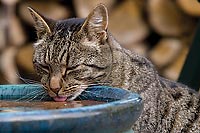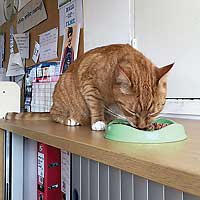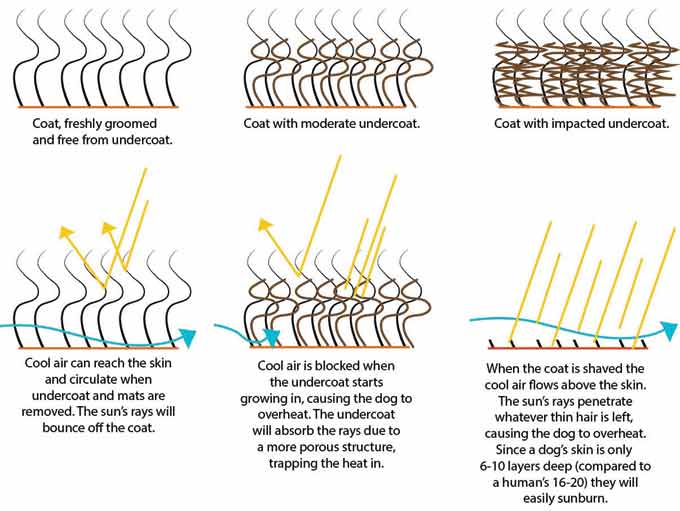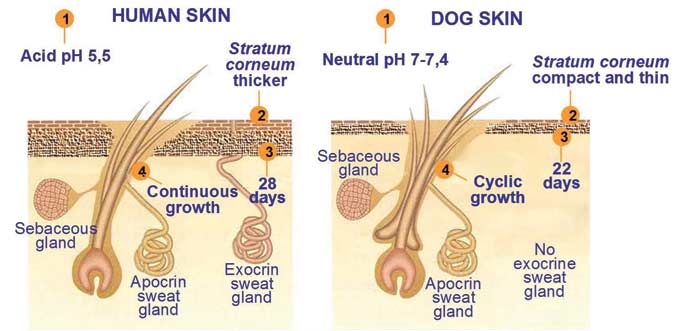What is Feline Whisker Fatigue?
By Kaye Davis
–Owner of the Moab BARKery |
I thought I was fairly knowledgeable when it comes to most things cats, but when I first heard about ‘whisker fatigue’ I thought it was just another clever marketing gimmick to help drive sales of designer cat food bowls. In my research I am finding there’s more to it than that. Did you know that your cat’s whiskers can get tired? It is true and whisker fatigue could be causing your cat some serious stress around mealtimes. Whisker fatigue is something that a lot of cat owners have probably never heard of, but it could be making your cat an unhappy feline.
Whilst a cat’s whiskers are essentially just thick, long hairs that protrude from the sides of their face what makes them special and ultra-sensitive is the fact there is a sensory organ called a proprioceptor at the end of each whisker, which sends messages to the cat’s brain and nervous system. A cat’s whiskers are so sensitive that they can detect movements in the air, sensing the size and shape of nearby objects before they reach them. This allows a cat to sense and navigate around a piece of furniture in a room in the dark of night, judge tight spaces and whether they’ll fit, and sense the outline of prey when hunting to capture and kill in the most effective way, even it’s only a toy mouse in the comfort of your living room.
Whiskers are vitally important to your cat, so if they get damaged, fatigued or become stressed by coming into frequent contact with a surface such as the side of a food bowl during meal times it can cause huge discomfort. This can quickly turn meal times from a pleasurable experience for your cat into a stressful and painful situation. A water bowl with high sides can cause the same problem for cats that suffer from whisker fatigue.
If your cat exhibits any of the following behaviors at meal times, whisker fatigue could be the problem:
- Paws or pulls food out of the bowl before eating on the floor
- Makes a huge food mess on the floor
- Leaves food in the bowl but still seems to be hungry
- Eats only from the center of the bowl
- Hesitates before eating, stands near the bowl or paces around the outside
- Has to have the bowl be filled to the brim even when it is not empty
- Behaves aggressively towards other pets at meal times.
|
Cats are known for their finicky eating habits. Often we assume that when a cat isn’t eating at meal times, the problem is the food. But sometimes, and especially if your cat is showing signs of whisker fatigue, the problem could be the food bowl. Preventing whisker fatigue is simple; you just need to minimize any contact between food and water bowls and your cat’s whiskers. 
There are several cat food bowls on the market that are designed to relieve and prevent whisker fatigue. Look for a food bowl that’s designed with a shallow, wide shape so your cat can easily access her food without having her whiskers stimulated or pulled back. The right design will also prevent your cat from having to painfully push their nose into the inside edges of the bowl in order to get to the food there. When it comes to water bowls, on the other hand, look for one that’s wide so your cat can drink the water from the middle of the bowl without affecting the whiskers.
When shopping for your cat’s food and water bowls opt for those that are made of non-porous materials. Stainless steel is the best option, followed by glass and ceramic. Plastic cat food bowls are not recommended, even if they are deemed “food safe” because the material can develop micro-abrasions where bacteria could grow. The bacteria, which might persist despite the bowls being washed, would then come into contact with your cat’s face and nose, potentially resulting in feline acne.
Mealtime is an important part of your cat’s day, so if you find that your pet is hesitating or wants to take their food to go because they would rather not eat out of the bowl, they may be suffering from whisker fatigue. A simple swap of the food bowl for one that’s ergonomic and designed to prevent whisker fatigue could help.
|
|
De-shedding VS Shaving a Double-coated Dog
By Jessica Turquette
–Owner of the Moab BARKery |
Summer in Moab is hot! There are different ways to help a dog manage the heat of summer here. If your dog is double coated they are better off being de-shed than shaved. Double-coated meaning the guard hairs stop growing at a certain length and they shed undercoat regularly. Most dog owners know that their dogs need to be brushed, but don’t know why it’s so important. Dogs have up to 8 hairs in each follicle, only 1 of them is a guard hair the rest are undercoat. The guard hair does not fall out, it’s meant to be permanent but the undercoat is meant to fall out regularly. The undercoat grows in different stages, so there is continuous growth. Brushing weekly will remove the longest and oldest of the undercoat, while distributing sebum from skin glands that help maintain the guard hair and keep it watertight. Elbow grease plus the right brush can make easier work of this task. Many people don’t get enough undercoat removed regularly, and it gets packed against the skin creating a mat. Many people think that shaving helps the most, but it has drawbacks. If possible we try and remove the undercoat, but if it’s too matted often it has to be shaved off. De-matting a dog is very painful, but regular brushing at home or regular trips to the groomer can keep any dog in excellent condition.

De-shedding a coat leaves the guard hairs intact and removes the majority of the undercoat. This method allows the coat to maintain UV protection, and allows for maximum air flow while protecting the skin. Dogs have skin that is 25% thinner than humans, so they rely on their coat to help maintain body heat and protect them from the environment. One of the best places to de-shed your dog at home is in the tub. When the coat is lubed up with shampoo the undercoat comes out easily. Although it’s a messy job, it’s much better than all that dry hair blowing around when you brush Fido dry. Try different tools like rakes, combs, slickers, and shedding blades. Brushing their coat with shampoo allows the cleaning agents to get down to the skin. Don’t forget to condition and rinse well for the best result. We use a high velocity dryer to do most of the work on the undercoat, this is the groomer’s best tool! It can remove 90% of the loose undercoat with no brush at all. The same result can come from air drying and a long brushing session after the bath. We recommend forced air drying, hand held and home units are available for the same price as a Furminator brush!
Shaving the coat makes all the hair one length while losing the protection of the guard hair. Then all the undercoat grows back at the same length making the coat look thicker, and harder to brush. The dog will be much cooler but they lose skin protection for a while. The worst result of shaving a double coated dog is that rarely the hair doesn’t grow back, or worse grows back patchy. Most dogs grow their coat back just fine, and if your dog is severely matted it’s the most humane choice possible, but make sure to protect their skin while it’s growing back. 
|

|
Dog Friendly Walks/Hikes in the Moab Area |
| Trail or Walk |
Difficulty |
Length
(one way) |
Proximity to Downtown |
MillCreek Pathway
|
easy |
1.1 miles |
Little to no driving
Starts at 100 S & 100 W |
Portal Overlook
(trailhead @ Jaycee Park) |
Hard |
2.0 miles |
25 min drive N on US-191 to W on Utah 279 (4.2 miles) |
| Moab Rim |
Hard |
3.0 miles
(to Hidden Valley trail) |
8 minute drive
2.6 miles down Kane Creek Blvd from US-191 |
Negro Bill Canyon
(aka William Grandstaff Canyon) |
Moderate |
2.0 miles |
10 minute drive N on US-191 to
W on Utah 128, 3 miles |
| Hunter Canyon |
Easy |
2.0 miles |
25 minute drive (mild off-road)
7.5 miles down Kane Creek Blvd from US-191 |
| Corona Arch Trail |
Easy/Moderate |
1.5 miles |
25 minute drive N on US-191 to
W Utah 279 (10 miles) |
Hidden Valley
(trailhead at end of Angel Rock Rd)
|
Hard |
2.0 miles |
10 minute drive
S on US-191
3 miles to Angel Rock Rd |
Fisher Towers
(trailhead 2.2 miles off Utah 128)
|
Moderate |
2.2 miles |
35 minute drive N on US-191 to Utah 128, then 21 miles |
Tips for enjoying your time with your dog here in the Moab area:
- Bring lots of extra water for you and your dog.1 gallon per day for every 60lbs of dog!!
- Don’t let dogs chase wildlife (especially coyotes, they can lead dogs into an ambush).
- In the city, dogs are required to be leashed, but on public lands off leash with voice control is allowed.
- Slickrock and sand is very abrasive! Check paw pads often, or buy and use booties.
- If it’s over 85 degrees only consider early AM or late PM hikes, daycare or leave your dog at home.
- Pack out my poop! Seriously or the other hikers without dogs will eventually demand no dogs allowed!
|
To see past articles about animals, pets and their care check our archives. |